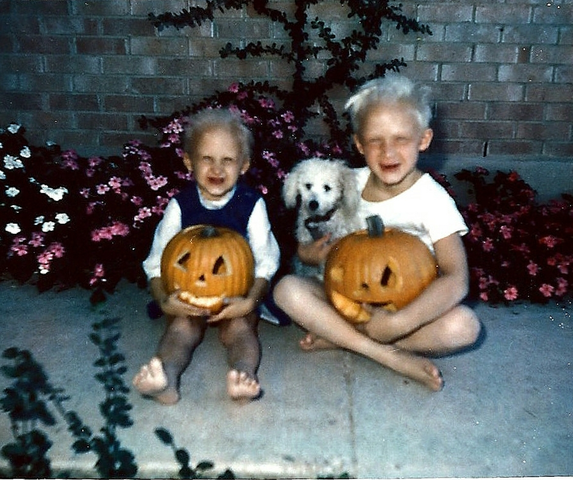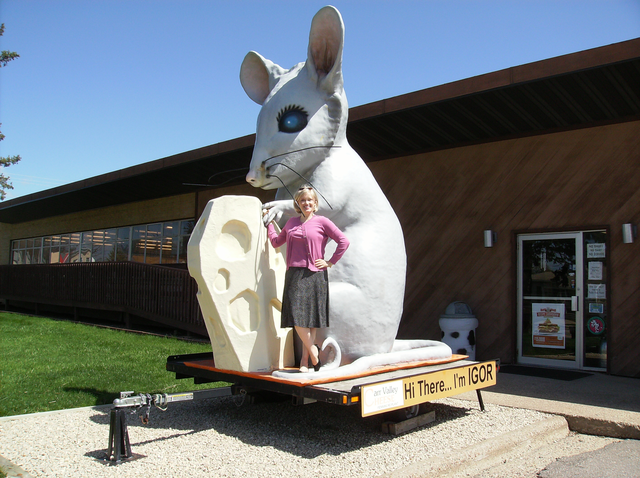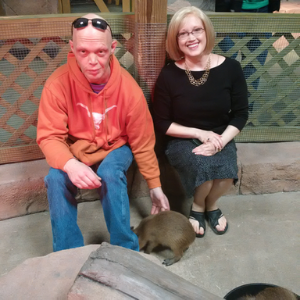By Lynne M. Thomas
The Van de Graaff machine seemed like something out of the Star Trek movie to my 1980s high school classmates and me. I watched as my classmates took their turns to place their hands on the globe, and we all laughed as their hair stood on end and they felt the static in their bodies. It was such a clean bit of fun.
When I stepped forward for my turn, though, I remember feeling nervous because I wore a wig. And I didn’t know if the machine worked on wigs! But as I touched the machine I felt nothing. Zero. Zip. Even my hair under my wig didn’t move a muscle.
It turned out that you have to have some natural moisture on your hands to attract the static in the machine. Who knew! Because of autosomal recessive hypohidrotic ectodermal dysplasia (ARHED), I never have moisture in my hands and am constantly putting lotion on after I wash them.
The Van de Graaff machine just didn’t work on me. The wig was all forgotten as my classmates were fascinated by my ability to touch the machine with no consequences. I found out later that my brother, Jefferson, who also has the same ARHED, had the same experience when he was in that grade.

Getting My Grip
My experience with the Van de Graaff machine prepared me for what I encountered years later when I joined the Curves workout program. That program uses a rotation of machines and rest stations for your workout. They are very big on you taking your pulse and making sure you stay within a range.
They encourage you to use the grip sensors on their machines when you’re on them to track your pulse as you go. Remembering my high school experience, I tried to tell the owner of the location where I joined that the grip sensors would not work on me. She dismissed me and insisted that I try.
Despite not wanting to put my hands on the germy sensors, I did it. Nothing happened. The machine didn’t register anything. She thought something was wrong with the machine. It became a teaching moment for me to share how God had designed my body. To her credit, she was humble and interested.
Missing Prints
But none of the foregoing prepared me for what I experienced standing in front of a weapons carry class being fingerprinted so I could get my carry license. The instructor was a great guy with decades of law enforcement and weapons experience.
He began by fingerprinting the first four fingers of my right hand. After each one he frowned, moving even more slowly and carefully to roll nail to nail. By the time he got to my fourth finger, he concluded that I did not have distinct enough swirls to work on ink. I needed witch hazel to bring out my swirls or a digital fingerprinting process. He joked with me about having sandpapered off my fingerprints.
Honestly, I was a little embarrassed. I’d been fingerprinted years ago when I got my Texas law license. But nobody said a word back then. So the instructor sent me on my way. I happened to mention the situation to my brother, Jefferson, and he had the information I needed.

Broken Swirls
It turns out that he’s had the exact same experience…every time he’s been fingerprinted. As former law enforcement and someone who’s carried a weapon for years, he’s been fingerprinted a number of times. Apparently, no one who’s ever fingerprinted him had ever seen swirls like ours. Ours are broken swirls. We have perfectly fine ridges…but just completely broken swirls.
I pulled out my old fingerprint card from decades ago, and sure enough the broken swirls were obvious. My brother said the state of Texas probably didn’t care that my fingerprints looked odd back then because I wasn’t asking for a carry license.
In case you think he and I don’t have fingerprints, that is not true! We have fingerprints….they just don’t look like those of other people. In that sense, we have even more unique fingerprints than other people!
Our Uniqueness
My brother’s wisdom didn’t end with the swirls explanation, though. He pointed out to me that he’s never had the same grip as other people, and he attributes that to the broken swirls in his fingertips. I’d never thought of that either, frankly, but realized how correct he is. I’ve always struggled with hand sewing and embroidery when I’m pulling the needle through. The needles slip easily from my grasp. Again…Who knew!
What I know now is that God’s design for my brother and me as people with ARHED is even more special than I thought. That design really is in our hands…quite literally.
Lynne M. Thomas is a guest blogger for the National Foundation for Ectodermal Dysplasias (NFED). She describes herself as a recovering attorney and full-time daughter and focuses on helping others get financial, time, and health freedom. She lives in Fort Worth, Texas with her elderly mother, Barbara, and two feline children, Shakespeare and Tortellina. You can connect with Lynne at 866-343-2748.
Share Your Story
This was very interesting to read. Thanks for sharing and informing us.
Hi, Janet. You’re welcome. Has either you or your child experienced what I have? Lynne
Wow, I also have ED and struggle with sewing needles. I chalked it up to no moisture, but see that the lack of moisture combined with odd fingerprints is why I struggle with sewing needles, among other similar items. Thanks!
Hi, Eileen. Isn’t it great when we have these aha moments! Yes, many of our families have mentioned experiences like yours… issues gripping pencils, too. It can be good to understand why. Take care, Jodi, NFED, Director, Marketing and Communications
Hi, Eileen! Glad my story helped you. I also have a hard time keeping thimbles on my fingers. Maybe that’s connected, too. 🙂 Lynne
I had this happen in 1970 obtaining a Federal Job I had to be fingerprinted and the person kept adding ink to my fingers trying to get imprint. Took me days to get ink off my fingers! Imprints were sparse, they just turned in with paperwork and moved on.
Hi, Ann. What a pain with all that ink! But, we’re glad that they moved you forward to the job anyway. Whew! ~ Jodi, NFED, Director, Marketing and Communications
Good afternoon, Ann! Thank you for sharing what happened to you. It makes me feel better knowing others understand. 🙂 And I understand about the ink. My nails are not affected by the ED and are naturally long. I think it was harder getting the ink off my nails than my fingers when I was printed for my law license. Ugh! Lynne
Found this very interesting, I’m a UK citizen and frequent visitor to US where I always have the embarrassment of having to repeat the fingerprint scan many times when going through security.
Currently visiting Orlando and having a nightmare getting into the theme parks every day
Hi, Barbara. I’ve never done much security fingerprint scanning at destinations, so that had never occurred to me! What makes them finally let you through? Lynne
This was a very interesting read! I will now be testing my daughters’ fingerprints for this unique code! She was diagnosed with Popliteal pterygium syndrome at birth then the doctors later gave us another diagnosis, but is still related to the previous diagnosis. She is said to have Bartsocas papas syndrome which is a very rare more lethal form of popliteal pterygium syndrome. She does have ectodermal dysplasia as part of her disorder. She has extra webbing behind the knee, fused eyelids at birth, sparse little to no hair, abnormal teeth, very dry peeling hands and feet along with abnormal thick short nails. She was presented with a cleft lip and palate at birth but has since had surgeries done. Her name is Alicia, She will be turning 10 this coming April 7th, 2020. With her disorder, it is said that children born with this disorder usually do not live very long and that most die within the utero or shortly after birth. She is our miracle child as you and your brother are miracles to your family! I always tell her every day she is very unique and there are only a few in the world like her. We encourage her a lot to chase your dreams and reach for the stars because no one can tell you that you can not do it because after all, you have already overcome lots of obstacles that others could never phantom.
The many questions we get on a daily basis have just become routine for us. I just have to remind my self and my daughter not to get worked up over it, just explain the disorder so those around us can be more aware and to remind our selves that they are curious and we spread awareness by explaining the disorder, what little we know as there is much more to learn that is still unknown.
Hi, Amber. Thanks for sharing about your wonderful miracle child. We love to hear that she’s defied the odds and doing well. Sounds like you are doing all the wonderful things a parent should in being positive. Keep up the great work! Let us know if we can ever help. ~ Jodi, NFED, Director, Marketing and Communications